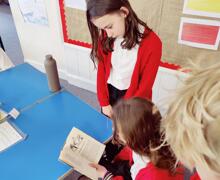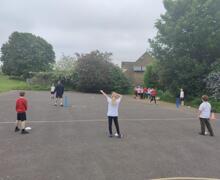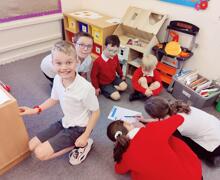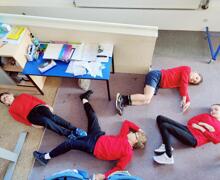- Home
- Curriculum
- Classes
- Cedar - Key Stage 2
- facebook Share this page on Facebook
- twitter Tweet this page
- pinterest Pin this page
Cedar - Key Stage 2
![]() Term 1 and 2 Project - Invasion
Term 1 and 2 Project - Invasion
In the Invasion project, the children will explore the concept of invasion, exploring the goegraphy of invasion and the reasons behind several of Britain's invasions. The children will learn about life in Britain after the Roman withdrawal and about Anglo-Saxon and Viking invasions up to the Norman conquest. The children will take a deeper look at King Athelstan and explore why he was a significant leader.
| Reading |
Class text: Impossible Creatures |
| Writing |
Journey (Narrative); The Colour Collector (Poetry); The Happy Prince (Narrative); The Gut Garden (Explanation Text) |
| Maths |
Year 3 & 4 - Place Value; Addition & Subtraction; Multiplication & Division; Area; Fractions Year 5 & 6 - Place Value; Addition & Subtraction; Multiplication & Division; Converting Units; Fractions. |
|
Invasion - History |
In the Invasion project, the children will explore the concept of invasion, exploring the goegraphy of invasion and the reasons behind several of Britain's invasions. The children will learn about life in Britain after the Roman withdrawal and about Anglo-Saxon and Viking invasions up to the Norman conquest. The children will take a deeper look at King Athelstan and explore why he was a significant leader. Walk to Minster Lovell Ruins |
| Religious Education |
Humanism What motivates Humanists to lead good lives? The children will explore the ways that Humanists motivate themselves to lead good lives and how this relates to other religions and their own lives. Christianity What is the Trinity? The children will explore what the Trinity is and link this to the Incarnation Big Frieze panel, how the Trinity is portrayed through art, words, and in various Bible stories all so that they can comprehensively answer the question: What is the Trinity? |
| Science |
Food and the Digestion System: This project teaches children about the human digestive system. They explore the main parts, starting with the mouth and teeth, identifying teeth types and their functions. They link this learning to animals' diets and construct food chains to show the flow of energy. Sound: This project teaches children about sound, how sound is made and how sound travels as vibrations through a medium to the ear. They learn about pitch and volume and find out how both can be changed. |
| Design and Technology |
Fresh Food, Good Food: This project teaches children about food decay and preservation. They discover key inventions in food preservation and packaging, then make examples. The children prepare, package and evaluate a healthy snack. |
| Art and Design |
Warp & Weft: This project teaches children about the artform of weaving and how it has developed over time, including the materials and techniques required to create woven patterns and products. Colour Theory: This project teaches children about colour theory by studying the colour wheel and colour mixing. It includes an exploration of tertiary colours, warm and cool colours, complementary colours and analogous colours, and how artists use colour in their artwork. |
| PE |
Swimming (Tuesdays - Term 1); Indoor (Jazz Fusion - Thursday - Term 2); Outdoor (Fridays) |
| Music | Unpitched Percussion - creating a nature soundscape using unpitched instruments, exploring the role of the conductor, exploring simple rhythmic values and different ways of writing music down. |
| Geography |
Interconnected World: This project teaches children about compass points and four and six-figure grid references. They learn about the tropics and the countries, climates and culture of North and South America. Children identify physical features in the United Kingdom and learn about the National Rail and canal networks. They conduct an enquiry to prove a hypothesis, gathering data from maps and surveys before drawing conclusions. |
|
|
Please ensure that children arrive on Thursday (Indoor) and Fridays (Outdoor) in their PE kits and bring a named water bottle with them.
Memorable Experiences
Minster Lovell Ruins - Thursday 11th September
The children have been learning about what happened after the Romans left Britain. As part of their history project, they enjoyed their walk to the atmospheric Minster Lovell Ruins, where they were able to step back in time and imagine what a Viking invasion might have looked like in such a historic setting.
The children are now using their experiences to deepen their understanding of the period and think carefully about the impact of invasions on life in Britain after the Romans left.
Pupil Voice:
"It felt like we were really there, defending the ruins from the Vikings!" - Ed
"I liked imagining the sounds of swords clashing and the shouts of warriors echoing through the ruins" - Lenny
"Walking through the countryside made me think about how far the Vikings would have had to travel to reach places like this." - Elliot

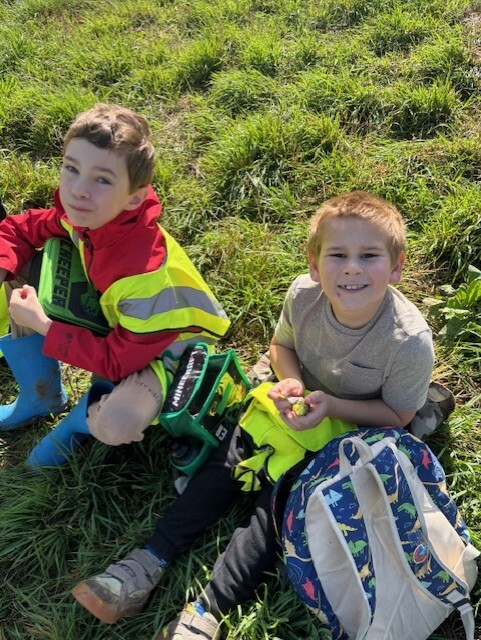
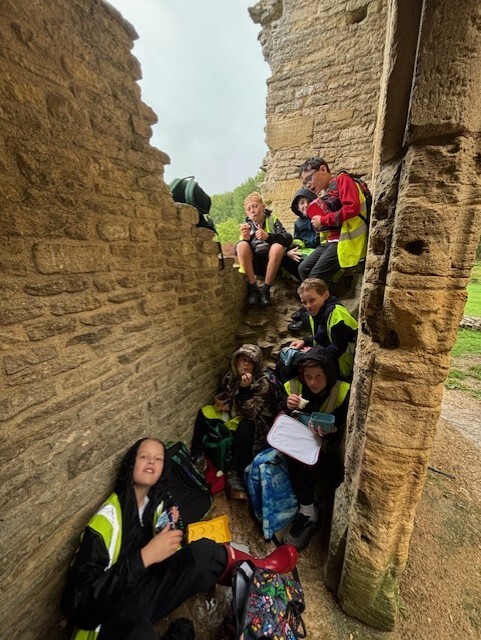
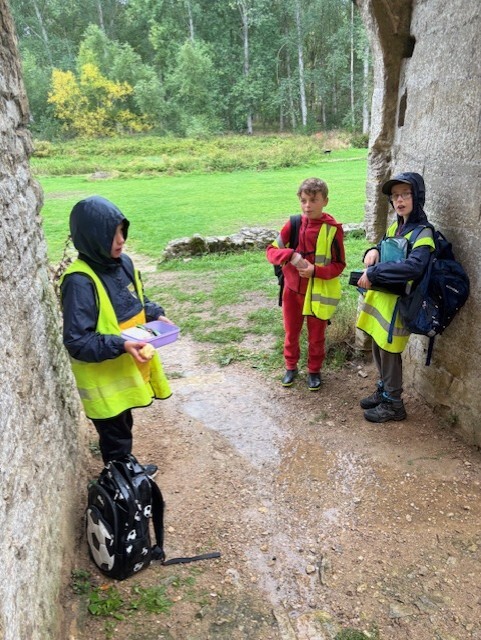
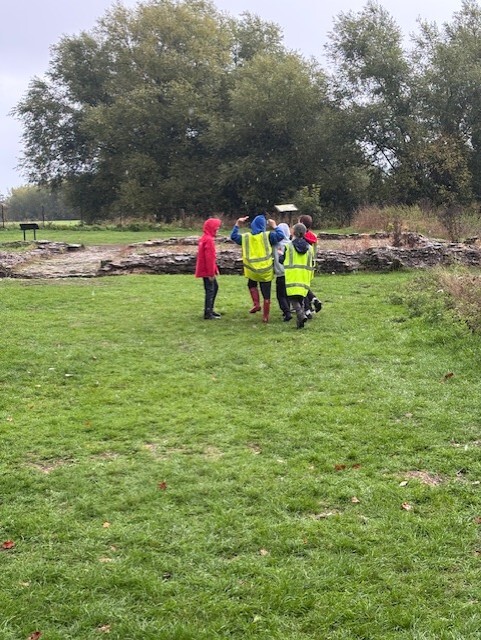
Home learning
Homework will be set on a Friday. Home learning journals will be sent home to be returned by the following Thursday. Activities and reading logs can be accessed via our online learning platform, Learning with Parents.
Log on to TTRS or Numbots to practice your times tables and number bonds. Try to do this 5 minutes a day - it really makes a difference! Log in details can be found in your home learning journal.
Reading Books
We hope that you will be able to read with your child for at least 10 minutes per day.
Every Friday we will have a library session during which your child will choose a new reading book to take home or continue with one they are already reading. Books cannot be changed for a new text unless the previous one is returned.
Times Tables Rock Stars, Numbots and Complete Maths
Please use your username and password to log into the platforms (it is the same for both). Here you can practise your number bonds and times tables. Certificates will be given out in Celebration Assembly on Fridays.
On Complete Maths the children will be able to acces learning to support what they are doing in class. These are bespoke projects, designed by their teacher to push their learning on.
https://ttrockstars.com/ - Time table practice. A specific times table will be set by your teacher weekly
https://numbots.com/ - Number bond practice.
https://auth.completemaths.com/login - Complete Maths Log in
Religious Education
Term 1: Humanism
Big Question - What motivates Humanists to lead good lives?
This term, we will be exploring the ways that Humanists motivate themselves to lead good lives and how this relates to other religions and their own lives.
Week 1
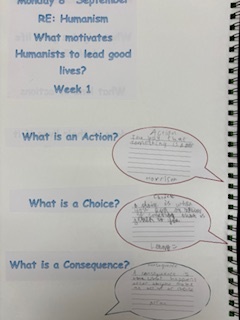


The children have explored what an action, a choice and a consequence is and how this leads to people making the right choices. They have also looked at examples of what they might do in life that is considered a choice, an action and a consequence. The children have attempted answering the Big Question in their Start of Project Reflections:
"Humanist are motivated by nature and science so they live a good life" - Arran
"Humanists lead god lives through their values" - Theo
Week 2
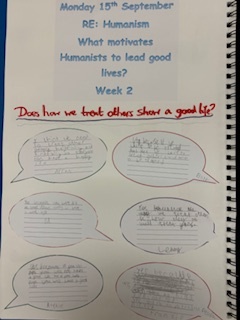
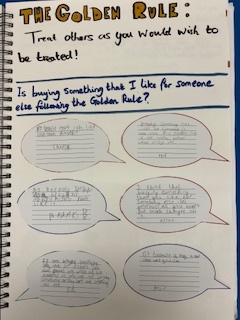
The children have, this week, considered the impact and the connection of how we treat people leads to living a good life. They were introduced to the golden rule "Treat others as you would wish to be treated" and then considered whether buying something that you like for someone else would be following that golden rule.
Week 3

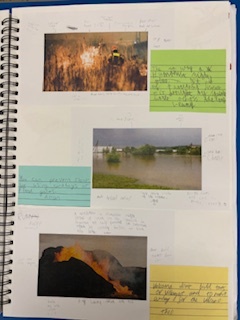
The children have now explored the golden rule and have this week considered how they think the world was created. The children provided answers such as the Big Bang, Evolution and God creating the world. A Humanist does not believe in a God and the children understood that they follow the scientific version of the world's creation. Bearing that in mind, the children explored how a Humanist might deal with natural disasters in the world and concluded that they would lean on each other for help and support.
Week 4


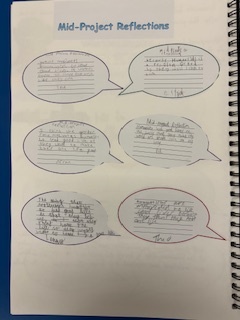
The children this week have consdered what they have learned in the project so far and have then explored another Humanist view on life. A Humanists believes that the is only one life and one planet. Therefore, they would want to look after the planet in order to sustain this for futre generations. The idea that Humanists believing that they only have one life brought up intriguing question regarding whether they would not be motivated to live a good life because they might view it as there being no consequence. However, the counter argument was discussed and they would only have one life going around and not being kind would go against their golden rule. They considered how they would look after the planet for future generations.
The children then answered the big question again at this point with their mid-project reflection.
Week 5

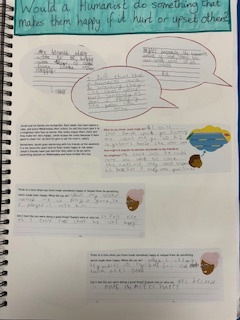
The children this week have been introduced to the symbol of Humanism and what this means. They understood it as "The Happy Human". This symbolises that humans should find and persue what makes them happy as long as it does not negatively impact others. They then considered how Humanists make choices and answered questions based on a scenario where someone is stuck in a dilemma and how they would overcome this.
Week 6
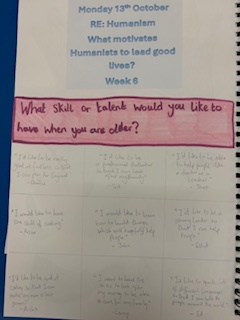
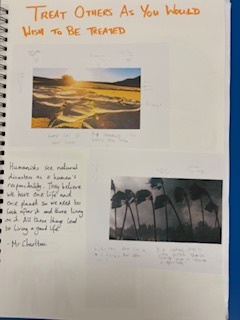

The children explored the end of project and have summarised everything that they have learned this term; the golden rule, the impact of how they live their lives and their motivations behind it, leading to the children being able to answer the Big Question: "What motivates Humanists to lead good lives?"
Term 2
RE: Christianity
What is the Trinity?
Week 1
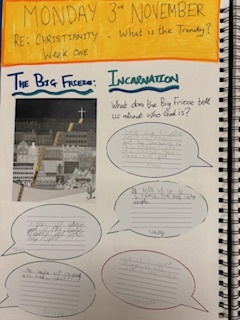
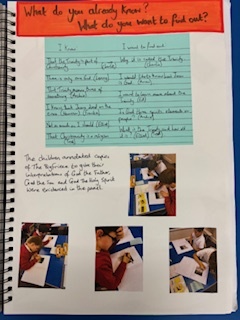
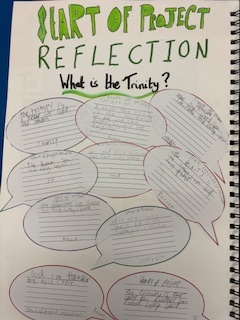
The children have started their second RE unit this term. The religion is Christianity and the concept is Incarnation. They are looking at the Big Question: What is the Trinity?
This week, the children viewed the Incarnation panel, which some of them have seen from units last year, but this time they have looked at what the Trinity is and where is can be seen in the Big Frieze. They understand the the Trinity is God the Father, Son and Holy Spirit, a concept that is difficult to understand. God is in three separate forms. They then answered the Big Question: What is the Trinity? as their Start of Project Reflection.
Week 2
The children have explored Matthew 3:11-17 - the Baptism of Jesus and have annotated the story to understand where the Trinity are within the Bible story. The children have then completed artwork to symbolise Jesus Baptism with all parts of the Trinity present.
Collective Worship
Acts 20:35: Remember the words of the Lord Jesus, how he himself said, it is more blessed to give than to receive.
2 Corinthians 9.7: God loves a cheerful giver
This term's Christian Value is generosity.
This half term, our Collective Worship has centred around the Christian value of Generosity—giving freely, joyfully, and with love.
Scripture Focus: “God loves a cheerful giver” We began by exploring the Bible verse from 2 Corinthians 9:7, which reminds us that generosity is not just about giving, but about how we give. Children reflected on what it means to be a cheerful giver and how generosity can bring joy to both the giver and the receiver.
The Story of Johnny Appleseed We linked our learning to the story of Johnny Appleseed, a man known for planting apple trees and sharing nature’s gifts with others. His kindness and selflessness inspired the children to think about how small acts of giving can grow into something much bigger. Pupils created beautiful artwork to celebrate the story and its message.
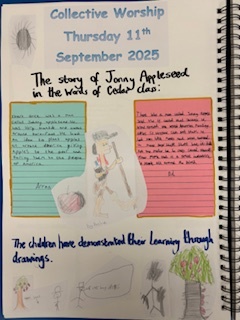
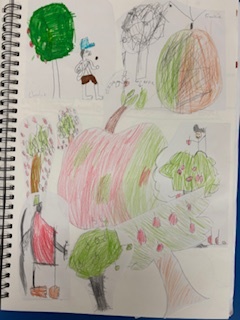
The Generous Widow We also listened to stories from the Gospels, including the tale of the Generous Widow who gave all she had, even though it was very little. This powerful story helped children understand that generosity isn’t about how much you give, but the heart behind it.

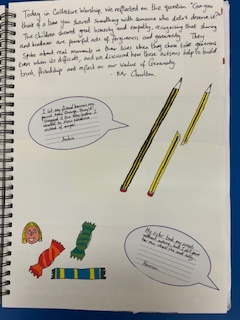
Good Deeds and Selflessness Through discussion and reflection, children shared examples of good deeds they’ve seen or done themselves—from helping a friend to donating to charity. We talked about selflessness and how giving without expecting anything in return is one of the most meaningful ways to live out our values.
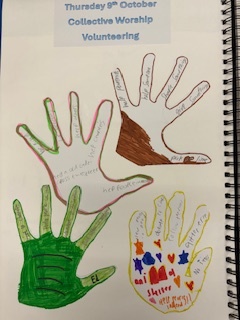
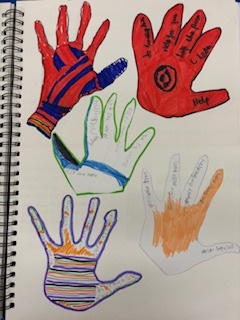
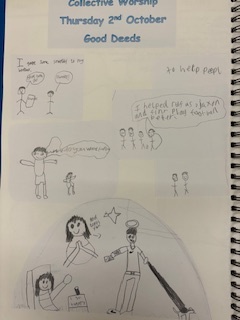
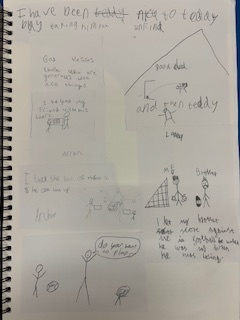
Living Generously Every Day Our worship has encouraged children to think about how they can be generous in their daily lives—with their time, their words, and their actions. Whether it’s sharing a smile, helping at home, or being kind to someone in need, we’ve celebrated the many ways generosity can shine through
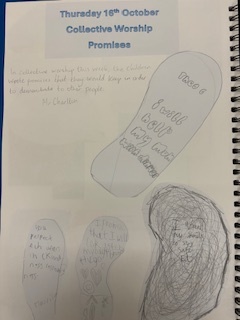
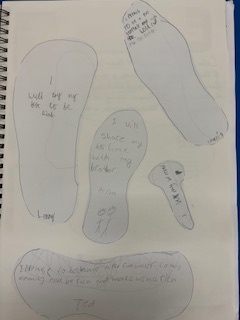
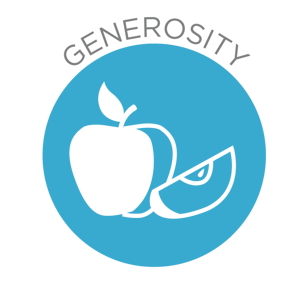
Prayer space
Prayer spaces enable children and young people, of all faiths and none, to explore life's questions, spirituality and faith in a safe and creative ways.
In our Prayer Space, the children have a choice of actvities to help them reflect and be mindful:
Generosi-Tree - This enables the children to reflect on our school Value of Generosity this term and think about the things they could be generous with and they stick these onto our tree.
Mindfulness Lego - A space to be creative and get lost in their imaginations, building various things with building bricks.
Listening Corner - In our classroom tipi, the children have a space to reflect and listen to the world around them
Big Questions - We have the opportunity to answer big questions in the world, including "What does peace look like?" and "How can we care for the planet?"
Curriculum
- Behaviour - Ready, Respectful, Safe
- Classes
- Curriculum Intent
- Home Learning - Learning with Parents
- Inclusion
- Junior Citizenship
- Mathematics
- Music Lessons
- Our Curriculum
- Our Library
- Reading and Phonics
- School Council
- Sport and Health
- Subjects: Modern Foreign Language
- Forest School
- Memorable Experiences
- Year 6 Residential
- Enrichment Clubs
- Outdoor Learning and Play
- British Values
- Personal Development
- Eco School
- Express Events
- Writing



